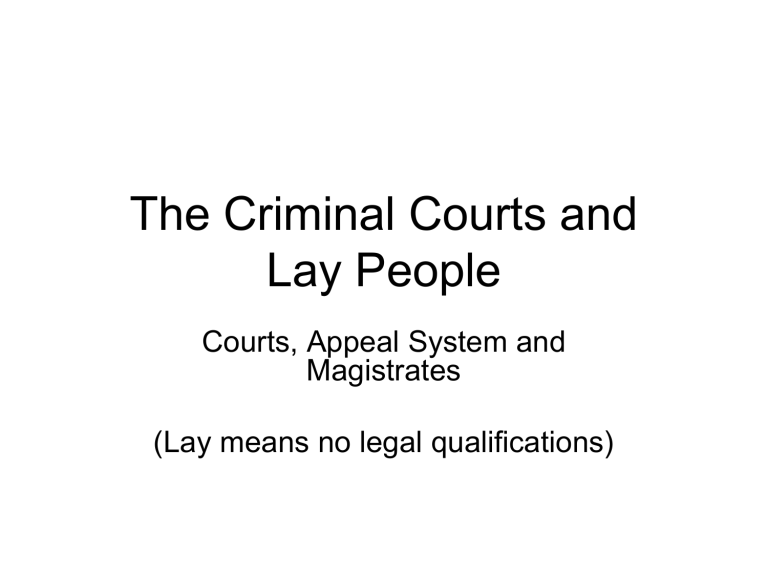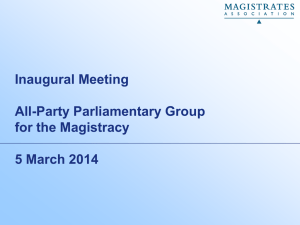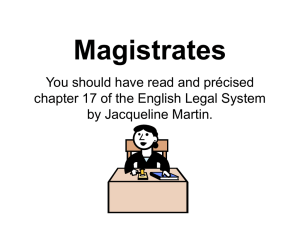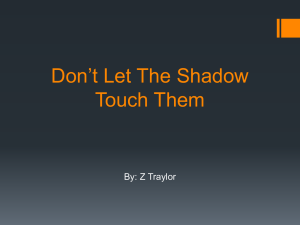File - Teaching With Crump!

The Criminal Courts and
Lay People
Courts, Appeal System and
Magistrates
(Lay means no legal qualifications)
Lesson Objectives
• I will be able to describe the criminal court structure and appeal routes
• I will be able to state the jurisdiction of each court
• I will be able to describe the qualification, selection and appointment of a magistrate
• I will be able to describe the training, role and powers of magistrates
Criminal Court Structure
Court for initial trial – Magistrates’ Court
First Appeal Court:
High Court (Queen’s Bench Division) – by way of case stated on point of law
Crown Court – Against conviction or sentence
Final Appeals
From High Court to Court of Appeal (Criminal Division and then HoL if no leapfrog procedure available)
From Crown Court to Court of Appeal (Criminal Division) and then to HoL
Appeal routes from magistrates’ courts
House of Lords
Point of law of public importance Leave to appeal from QBDC or HL
Queen’s Bench Divisional Court
No witnesses; appeal is heard on the basis of what the law is on the facts given by the earlier court
Case stated appeal
Case stated appeal - by: defence against conviction or prosecution against acquittal where they claim the magistrates made a mistake about the law
Crown Court: case is reheard by judge and two magistrates
The normal route -
Defence only
Trial at magistrates’ court
Court for initial trial: Crown Court
First Appeal Court – Court of Appeal (Criminal Division)
Final Appeals – House of Lords
Appeal routes from the Crown Court
House of Lords less than 10 cases / year
Point of law of public importance
Leave to appeal from CA or HL
Court of Appeal (Criminal Division)
Prosecution may appeal:
• if a judge’s error leads to an acquittal
• if jury has been nobbled
• if new and compelling evidence of D’s guilt
Defence may appeal against conviction or/and sentence
Leave to appeal from CA or certificate from trial judge
Crown Court Trial on indictment by judge and jury
The three categories of offence
Category of offence Place of trial
Summary Magistrates’ courts
Examples of offences
Driving without insurance
Common assault
Criminal damage under £5000
Triable either way
Magistrates’ courts or
Crown Court
Crown Court Indictable
(serious cases: triable before a judge and jury)
Theft
Assault occasioning actual bodily harm
Murder
Manslaughter
Rape
Robbery
Magistrates’ Court Jurisdiction
• Has some limited civil jurisdiction – but most work is dealing with criminal offences involving adult defendants
• Issuing arrest and search warrants, deciding on bail, conducting sending for trial hearings where indictable offence cases are transferred to the Crown Court, trying summary offences, trying either way offences that are to be tried summarily
• Deal with young offenders in the Youth Court – specialised form of Magistrates’ Court – not open to general public
• Deals with almost all cases involving under 18s
• Hearing is similar to Magistrates’ Court – although procedure is adapted to take account of age of defendant
• Specialist training given to Magistrate
Crown Court Jurisdiction
• Deals exclusively with serious criminal cases
• Work includes trying indictable offences, trying either-way offences that are to be tried on indictment, sentencing where the case has been sent by the Magistrates’ Court to Crown Court for sentence
(limited sentencing powers)
• Appeals from the Magistrates’ Court against conviction or sentence
• Appeals from Crown Court go to CoA (CD)
• Possible grounds for appeal include misdirection of law or facts, failure to a defence, inappropriate comments by a judge or jury irregularity
• CoA will allow appeal (and possibly order a new trial) if it considers the conviction unsafe
• Where the CoA quashes a conviction on a point of lae and the verdict of the jury shows that it was satisfied that some other offence had been committed, the CoA may substitute a conviction for that other offence
Magistrates
• Also known as justices of the peace
• Can be traced back to 1195 – Knights ensuring law was upheld
• 1327 – Act of Parliament set out appointment of men in every county to ‘guard the peace’
• 1361 – ‘Justice of the Peace’ name first used – role has developed since then
• Just under 29,000 lay magistrates in England and Wales
• Unpaid except for expenses – although the annual training budget is approx £500 per head
• Roughly equal numbers of men and women
• Supposed to reflect society as a whole and have a race and gender balance that reflects the make-up of the country and more importantly the local area of where they sit
• All part-time but must sit at least 26 half-days a year
• Constant appointments of people to be magistrates
• During 2005-2006 1,132 men and 1,080 women were appointed
Justices of the Peace – this number of appointments does not just include growth in the number of magistrates, but also turnover, as magistrates retire or stop being able to continue
• Lay M’s sit on a bench of 3 Ms and have a role in all criminal cases in some way, dealing with the entire criminal process for
95% of all cases
• Approx 1m cases heard in M’s Court each year with nearly 850,000 convictions in
2006-7
• Many cases involve more than 1 hearing, so workload is enormous
• There are some full-time, paid legally qualified magistrates – called District
Judges
Qualification, Selection and
Appointment
• Require no special qualification
• First requirement is the correct personal qualities and being able to commit to the time and effort of being a magistrate
• 6 general personal qualities that applicants should possess:
– To be of good character – including having personal integrity, keeping confidences and the respect and trust of others
– Understanding and communication – will have to understand documents, identify facts, follow evidence and concentrate for long periods of time – also need to be able to communicate effectively both in and out of court
– Social awareness – including an appreciation and acceptance of the rule of law, respect for people from different ethnic, cultural or social backgrounds, and an understanding of their local community
– Mature and of sound temperament – this will include awareness and an understanding of people, a sense of fairness, as well as humanity and courteousness
– Sound judgement – the ability to think logically, weigh arguments and come to a sound decision, as well as having an open mind, being objective and recognising and controlling prejudices
– Commitment and reliability – includes being committed to serving the community and making the necessary time commitment
– the applicant must be willing to undergo training, be in good health to undertake duties regularly. Support of family and employer is essential
• The second requirement is the willingness to take the Oath of Allegiance
• British Nationality is not a requirement, although those in process of seeking asylum cannot be appointed
• Certain professions and occupations are ineligible because of the M’s duty to be impartial – police and armed forces and if the M has been selected as a prospective candidate for election to the HoL or any other parliament or assembly
• There is discretion in the area but the concern is over whether there will be a conflict of interest – so list could be extended in individual cases
• Guidelines also apply to the occupation of the potential M’s spouse, partner and even close relatives
• Guidance notes for applicants give more details, as it would be unacceptable if previous occupations prevented someone from becoming a M
• Applicants also have to disclose whether they are a freemason
• Third requirement relates to criminal convictions and civil claims
• This is effectively an extension of the quality of good character and integrity
• Applicants must disclose any convictions, however minor including motoring offences for which a fixed penalty was payable and even police cautions
• Disclosure is also required of other criminal or civil orders, including details of divorce and maintenance orders
• The Rehabilitation of Offenders Act 1974 does not apply to the application, so even minor motoring offences that are 20 years old have to be disclosed
• The effect of this is that anyone who, or whose spouse or partner, has been convicted of a serious offence or even a number of minor offences will not be appointed if it is thought the Advisory Committee (which advises on the appointment of Ms) that the public would not have confidence in them as a magistrate
• A serious offence is regarded as anything other than a minor motoring conviction for which one received points on one’s licence and/or a fine, although very old convictions of this nature are not regarded as serious
• No formal age requirement – must be a minimum of 18, must retire from the bench at 70
• 5 years’ service is normally expected before retirement – meaning that anyone over 65 is unlikely to be appointed
Selection
• Number of stages
• When new M needed, advert placed in area where needed
• Usually part of a local campaign to recruit more M’s
• Public awareness days in some courts – potential M’s can learn about what is involved
• Can apply to be an M in either their home or work locality
• Standard application form from the Ministry of Justice – can be downloaded or printed from their website – DVD also included in the application pack
• Must complete application form
• Straightforward and reflects the eligibility criteria – can be online or as a hard copy
• Once form is submitted, it is checked to see if applicant is eligible – if they are, invitation to a first interview is sent by Advisory
Committee (local people including some M’s)
• If successful at first interview, there is a second interview
• Here there are practical examples of the sort of cases M deal with and they are discussed
• Background checks are made for conflicts of interest
• In making recommendations, AC consider suitability of candidates and number of vacancies
• The view of the AC is then sent to the Lord
Chancellor who will make the appointments
Appointment
• M’s are then appointed by the Secretary of
State and Lord Chancellor on behalf of, and in the name of, The Queen
• New M’s will then meet their colleagues and begin their training
Training
• Judicial Studies Board has overall responsibility for
M’s training
• Training operates through regional Courts Board areas – each area has responsibility for delivering training to M’s
• The Justices’ Clerk (M’s legal adviser) for the area is responsible for delivery, and a local Magistrates’
Area Training Committee sets the training priorities and agrees a training plan each year
• The Magistrates’ Association is consulted on training, and works with the Judicial Studies Board to develop materials
• Each year the Court Service and the Judicial Studies
Board produce a document setting out the minimum training provision for M’s – this sets out the essential minimum training provision and desirable additional training – not all training is for all M’s
• The compulsory training programme for newly appointed
M’s is designed to prepare them for sitting in court
• Usually delivered by the Justices’ Clerk – includes a basic intro to the roles and responsibilities of a M, including preliminary reading and 3 days of training, at least 3 court observations, a visit to a prison, a young offenders institution and a probation service facility
• After this is successfully completed, the new M can start to sit in court – they will then develop in their role as they deal with real cases as one of the 3 M’s sitting on the bench
• After about a year, a new M will receive consolidation training
– normally be for equivalent of 2 days – includes training on law and procedure as well as skills development
• Most effective way to develop as a M is to learn from the experience of sitting in court
– therefore all new M’s are given a mentor
• Mentors are experienced M’s who have been specially trained for this role
• During the first year, a new M will have 6 sessions with a mentor – sessions are used to discuss the day’s events in court with the mentor (who has been present through the day) and to reflect on how knowledge and skills have been applied during the day
• One possible outcome is to identify further training and development needs – after the first year, the new magistrate will have their first appraisal
• After at least 2 years there may be opportunities to do specialised training – to sit in either the Youth Court of the Family
Proceedings Court, or to undertake training to become chairman of the bench
• Training is also undertaken to cover things such as new legislation or sentencing policy as well as refresher training
Role and Powers
• The Lord Chancellor’s Directions for Advisory Committees on
Justices of the Peace state that ‘each bench should broadly reflect the community it serves in terms of gender, ethnic origin, geographical spread, occupation and political affiliation’
• This enables M’s to act in an appropriate manner to ensure that the community in which they serve can deal with local issues
• A M is required to sit for at least 26 half-days each year – normally work as part of a bench of 3 M’s – there is a chairman and 2 wingmen, who are often less experienced than the chairman
• As M’s are not legally trained, they always have available to them the advice of a qualified legal adviser – this is a justices’ clerk or assistant clerk, who is also responsible for effective case management and the avoidance of delay in court
• The legal adviser explains the relevant points of law and legal procedures to the M and gives advice on possible sentencing options
• The actual decisions are made by the M’s alone, as they decide on guilt or innocence based on the findings of fact that they make
• The M decides on sentence, but must act within their powers
• The adviser will make sure that the M’s are aware of the latest guidelines and policies on sentencing, but the M’s make the decision and the chairman of the bench announces it to the court
• The adviser carries out many administrative roles – preparing for court sessions ad making sure that all relevant papers and exhibits are ready, reading charges to the court, dealing with the paperwork for legal aid and completing bail forms, managing court schedules and training M’s
• This means the M’s can concentrate on the evidence in the case and the appropriate sentence, rather than being burdened with tasks that require specialist knowledge and expertise
• M’s hear less serious criminal cases and commit serious cases to the higher courts – where the case will be heard by a judge or recorder
• M’s cannot impose sentences of imprisonment of more than 6 months (or 12 months for consecutive sentences) or fines exceeding
£5,000
• M’s can also sit in the Crown Court with a judge to hear appeals from Magistrates’ Courts against conviction or sentence; and proceedings on committal to the Crown Court for sentence
Removal
• Must retire at 70
• Complaints about conduct of M’s are dealt with under the Judicial Discipline
(Prescribed Procedures) Regulations 2006
• There are likely to be a number of complaints, given the number of M’s
• Criticism of a M’s behavior, in or out of court, may come from sources including:
– Other M’s
– People in their court
– Members of the public
– The press
– Police or CPS
Complaints are investigated on behalf of the Lord Chancellor and the Lord
Chief Justice by Advisory Committees and their support staff, and staff in the Office for Judicial Complaints
• Failure to meet standards of behaviour required, or to attend sufficient sittings, can result in removal
• In the Office for Judicial Complaints’ first year from 2006, there were 28 complaints that resulted in disciplinary action – the action was removal of 15 M’s
• Alan Mitchell 68 year old M was reprimanded after a colleague overheard him complaining about ‘bloody foreigners’










